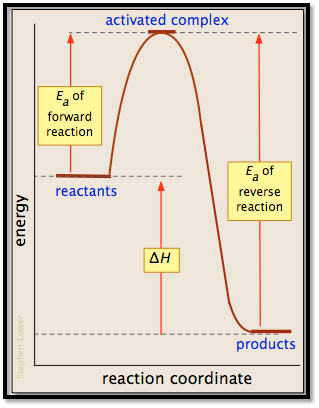Chemistry
10th Edition
ISBN:9781305957404
Author:Steven S. Zumdahl, Susan A. Zumdahl, Donald J. DeCoste
Publisher:Steven S. Zumdahl, Susan A. Zumdahl, Donald J. DeCoste
Chapter1: Chemical Foundations
Section: Chapter Questions
Problem 1RQ: Define and explain the differences between the following terms. a. law and theory b. theory and...
Related questions
Question
Can i get help step by step

Transcribed Image Text:### Understanding Activation Energy
**Question:**
What is the activation energy for the reaction B → A in the following diagram?
**Diagram Explanation:**
The diagram is a reaction coordinate graph with energy on the vertical axis and reaction progress on the horizontal axis. The graph features a curve representing the energy changes throughout the reaction.
- **Points on the graph:**
- **A**: Initial energy level of reactants.
- **B**: Energy at the peak of the curve, representing the transition state.
- **C**: Energy level of the products.
- **D**: Distance from the reactant's energy level (A) to the peak (B), indicating the activation energy.
- **E**: Distance from the reactant's energy level to the product’s energy level.
**Choices:**
- B
- D
- E
- C
- A
### Answer:
The activation energy for the reaction B → A is represented by the energy gap between points A and B on the graph, labeled as **D**. Hence, the correct answer is **D**.
Expert Solution
Step 1
The minimum energy that is required to form the product from the starting material is termed as activation energy. A graph for the progress of a reaction illustrating the activation energy for the reaction is given as,

Trending now
This is a popular solution!
Step by step
Solved in 2 steps with 2 images

Knowledge Booster
Learn more about
Need a deep-dive on the concept behind this application? Look no further. Learn more about this topic, chemistry and related others by exploring similar questions and additional content below.Recommended textbooks for you

Chemistry
Chemistry
ISBN:
9781305957404
Author:
Steven S. Zumdahl, Susan A. Zumdahl, Donald J. DeCoste
Publisher:
Cengage Learning

Chemistry
Chemistry
ISBN:
9781259911156
Author:
Raymond Chang Dr., Jason Overby Professor
Publisher:
McGraw-Hill Education

Principles of Instrumental Analysis
Chemistry
ISBN:
9781305577213
Author:
Douglas A. Skoog, F. James Holler, Stanley R. Crouch
Publisher:
Cengage Learning

Chemistry
Chemistry
ISBN:
9781305957404
Author:
Steven S. Zumdahl, Susan A. Zumdahl, Donald J. DeCoste
Publisher:
Cengage Learning

Chemistry
Chemistry
ISBN:
9781259911156
Author:
Raymond Chang Dr., Jason Overby Professor
Publisher:
McGraw-Hill Education

Principles of Instrumental Analysis
Chemistry
ISBN:
9781305577213
Author:
Douglas A. Skoog, F. James Holler, Stanley R. Crouch
Publisher:
Cengage Learning

Organic Chemistry
Chemistry
ISBN:
9780078021558
Author:
Janice Gorzynski Smith Dr.
Publisher:
McGraw-Hill Education

Chemistry: Principles and Reactions
Chemistry
ISBN:
9781305079373
Author:
William L. Masterton, Cecile N. Hurley
Publisher:
Cengage Learning

Elementary Principles of Chemical Processes, Bind…
Chemistry
ISBN:
9781118431221
Author:
Richard M. Felder, Ronald W. Rousseau, Lisa G. Bullard
Publisher:
WILEY